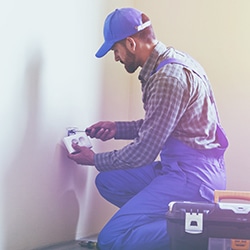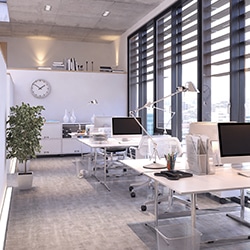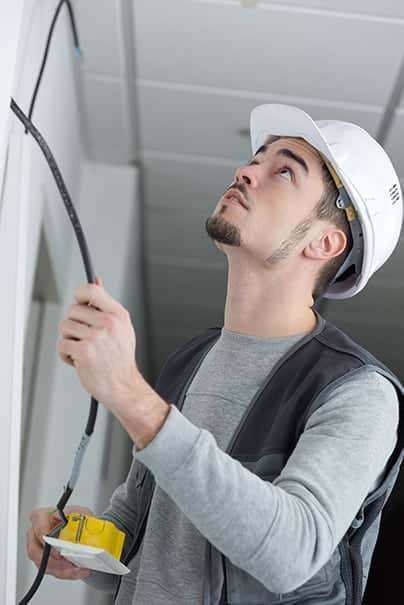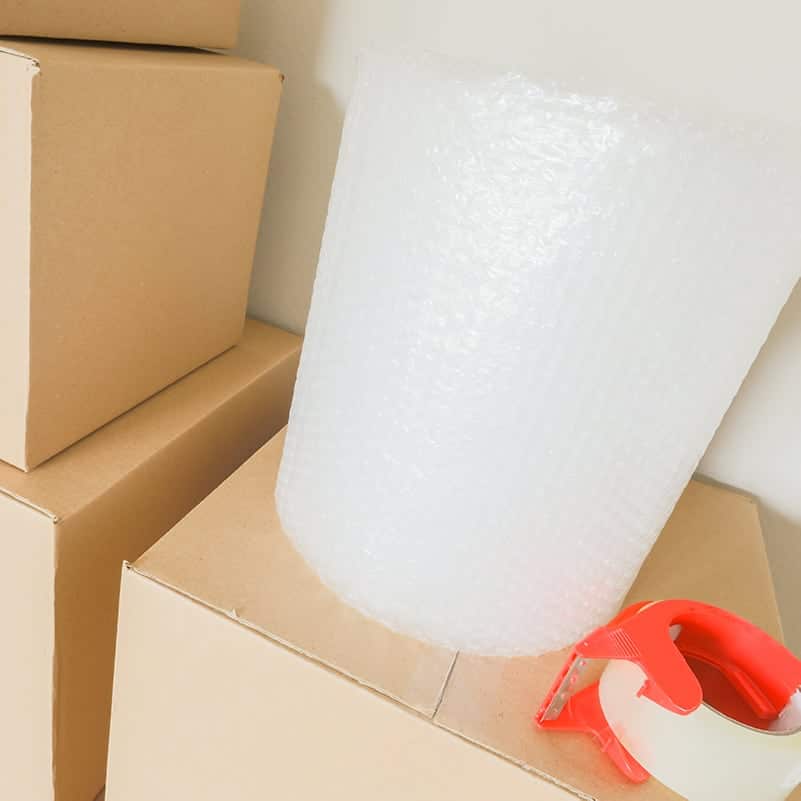Office Build-Outs
What Your Small or Mid-Sized Business Should Expect
Take this Information with You
Simply complete the form below to get a PDF version of this guide emailed to you.
If you are moving your business to an unfinished space…
the good news is that it’s essentially a blank canvas. You can have the new space finished to your exact specifications so it meets your needs perfectly. The not-so-good news is that this is usually a time-consuming and complex process that has to be completed on a very specific timeline.
Steps in the Build-Out Process
If you already know what you’re looking for you can simply click each of the links below to go directly to that section; otherwise, you can scroll through the entire document to read each step of the office build-out process.
- 1
- 2
- 3
- 4
- 5
- 6
- 7
- 8
- 9
- 10
- 11
- 12
- 13
- 14
- 15
If you’ve never coordinated an office build-out, you should be aware that deciding on the office layout is just one piece of the puzzle. There are many issues that need to be addressed from the time you have building plans until the time you can move into your new space. Even things that seem like they would be minor issues can be much more involved than you might think.
The decisions you make during the build-out process will affect the functionality and ambiance of your space for years to come. The more prepared you are, the smoother your office build-out and move-in will go. This can translate into less time to get the job done, less money spent and less stress!



This page details the chronological steps needed to get you, your team, furniture, and equipment situated in your new office space.
1 Hire a Commercial Office Furniture Installer to Manage Build-Out Details
If you’ve been chosen as the point-person for your office build-out, you have many details to consider. Did you know that one of your most critical partners in this process is a commercial office furniture installation company? An experienced furniture installer can assist you with aspects of the move and installation that you may not have otherwise thought about.
Even if you’ve handled this before, every office build-out is different with requirements that vary by city and from building to building. A commercial furniture installer can guide you through the various details long before furniture is installed. In fact, you’ll benefit most from their expertise if you bring them into the project as soon as you’ve chosen a general contractor for the build-out.
Your designated project manager with the furniture installer should first meet with you to evaluate your new office layout and where you plan to place furniture and equipment in the new space. This includes things like where to position electrical outlets so you have what you need where you need it. Or, how to organize your office furniture to maximize space and make the best use of natural lighting.
2 Conduct a Site Evaluation
The office furniture installation company’s project manager should contact the general contractor to schedule a site visit before major construction begins. During this initial visit, they can review the plans and be sure the electric and data outlets are going to be placed where needed and address any other concerns they may have for installing according to the plan.
They will visit again later to be sure that the construction has run according to the plan. If the office furniture installation project manager notices anything that would hinder the ability to begin furniture installation/reassembly, they would bring it to your attention and discuss with you and the general contractor exactly what needs to be completed.

3 Double Check Inventory, Instructions

Once the new office space is ready to be outfitted with furniture and equipment, your office furniture installation project manager should cross-check the records detailing which items are to be moved in and installed (ie: desks, conference tables, copiers… whatever your business needs installed in your space). If you will have new furniture or equipment brought into the office space, your project manager should consult those dealers to verify:
- the list of office furniture and equipment to be installed is correct.
- that all products have been received or there is an estimated delivery date.
- that the installer has all final instructions on how your office space should be laid out.
4 Ensure Required Paperwork Is in Order
Before you can begin moving into your new office space, your company must have clearance from the building owner or manager, work or construction permits, and have a valid certificate of insurance to work within the space. This paperwork and permits will vary depending on the location of your job. The office furniture installers can confirm these documents are in place and ready to go for the move to begin.
5 Schedule Technicians to Drop Cabling
Before any furniture is moved, your IT team should get involved to determine where the cables need to run and where there should be outlets. All furniture manufacturers make allowances for cables (internet, phone, etc); however, entry points for these cables vary according to furniture brand and style, and that can affect cable drops. The furniture installer’s project manager can be on-site when the data technicians are planning the drops to be sure there are going to be outlets for cables in the right locations for the furniture brands and the planned office configuration.
6 Schedule Electrician to Install Wall and Ceiling Feeds

As with data cables, electrical cables must be dropped from the ceiling or fed through the floor or wall. If furnishings have power poles that extend from the furniture to the ceiling (these are most commonly encountered with cubicles), this power pole must have internal separation and shielding to carry both data and electrical cables.
The City of Houston (along with many other municipalities) does not allow furniture installers to install electrical components into panels or stations. Instead, they specify that this must be performed by a city-approved, licensed, master electrical vendor. If you’re located in a municipality with this requirement, electricians will need to come in and make all of the “hot” connections, including the power to workplaces, and make any needed adjustments (such as relocating a light switch that is hidden behind a desk, etc.) Often, electricians are not familiar with particular office furniture brands and how the connections need to be made. Your office furniture installation project manager (who should be knowledgeable about various office furniture brands) can schedule and work alongside these electricians to provide guidance while they’re completing this task.
7 Schedule Hookup of Cables to Workstations
It’s around this time that your office furniture installer will choose a date for the workstations and other furniture to be installed. Once you have this date you can talk to your cabling company to be sure they will have a technician on-site also. During the first cabling visit, the technician planned out the lines to make sure they will have the right cables to serve the space’s configuration of desks, workstations, etc. During this second cabling visit, the technician will hook up all of the cables and verify that everything works as intended. This may be on the same day as the furniture installation. Once this is done the ceiling tiles can be replaced, work surfaces can be cleaned up, and put back together.
8 Revisit Jobsite and Contact General Contractor
After cabling has been installed and tested, you and your office furniture installation project manager should revisit your job site for a walk-through to ensure everything is where it should be and working correctly in the office space. Your furniture installation project manager should also contact the general contractor to verify that he/she agrees the space is ready to move in.
WHAT IF THERE ARE PROBLEMS? Your project manager should take the time to evaluate the situation, walk you through the issues, and provide you with our suggestions for a reasonable and cost-effective solution whenever possible.
9 Schedule Packing Material Delivery

In preparation for the transport of your existing office furniture and equipment to the new facility, it’s time to schedule delivery of your boxes, crates, labels, bubble wrap, etc. Ideally, these materials will be delivered to wherever your office furniture and equipment is located one week before the scheduled move date and crate pickup. If you have some things in storage or at multiple offices, be sure the materials are delivered to each of these locations.
10 Schedule Moving Truck
Your office furniture installation project manager should schedule a date and time for the moving truck to pick up, pack, and transport goods from your current office site and then schedule a date and time to deliver goods to your new office site. This isn’t always on the same day, but it can be. You may also need a weekend move to keep your staff working during regular business hours. Discuss what timing would work best for you with your project manager.
During this conversation, you should also discuss which items you need to pack yourselves (ie: desk drawer contents) and which things the installers will wrap or pack up for you such as computers, screens, etc.

11 Confirm All Details Prior to Moving Day
Before the moving truck arrives to pick up and then deliver your office furniture and equipment, your project manager should confirm clearance specifications, certificate of insurance, loading docks, equipment elevators, etc. They should also re-confirm your move date and times with both building managers (the building that you are leaving and the building that you are moving in to.)
12 Schedule Start and Completion Dates for Furniture Installation Crew

After the moving truck has been unloaded, furniture installers will work onsite to install all furniture and equipment in the new office space. While your installation team is onsite, your office furniture installation project manager should, ideally, provide daily updates on your how things are progressing and send photos so you can see the progress for yourself without having to travel to both the old and new locations.
13 Moving Day!
After the moving truck has been unloaded, furniture installers will work onsite to install all furniture and equipment in the new office space. While your installation team is onsite, your office furniture installation project manager should, ideally, provide daily updates on your how things are progressing and send photos so you can see the progress for yourself without having to travel to both the old and new locations.
14 Schedule Final Check After
Move-In is Complete
Before you take occupancy of your new office, you and your project manager should walk through and complete a list of final punch items, such as ensuring that desk locks and task lights are working correctly, sit-stand desks move up and down as intended, etc. Additionally, you should carefully evaluate all of your furniture.
If there was any damage to your furniture or equipment caused by any of the vendors during the moving process, that should be documented so you can seek reimbursement, repair, or replacement. The office furniture installation team you hired should have someone onsite while you take occupancy, so they can quickly address any issues or change requests.
15 Feedback and Troubleshooting
After you move into your new space, ask your employees to let you know about any problems or incomplete work they notice. If you’ve hired a reputable furniture installation company, they should agree to immediately address any issues you bring up until you’re satisfied the job has been completed correctly and to everyone’s satisfaction!
Take this Information with You
Simply complete the form below to get a PDF version of this guide emailed to you.
